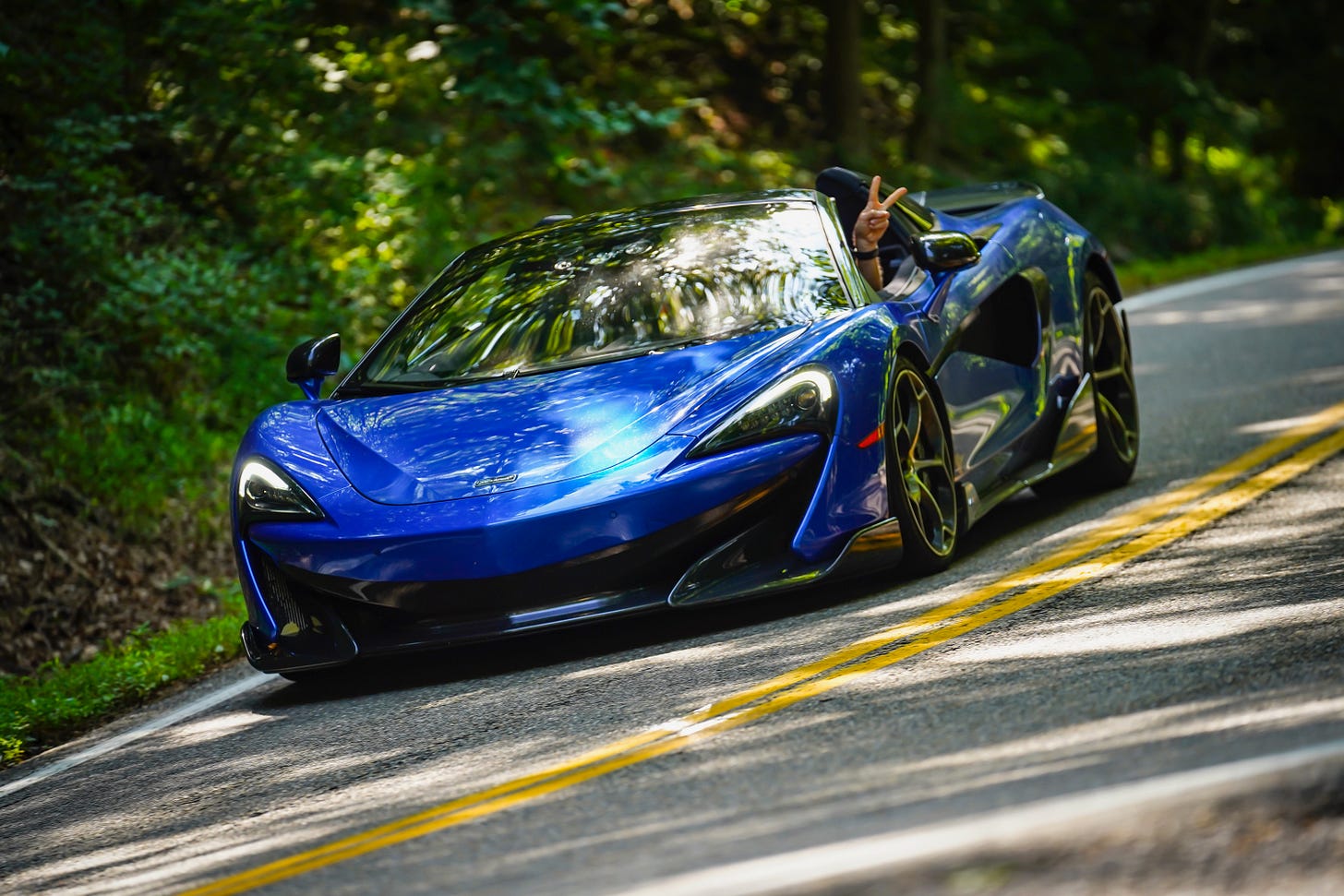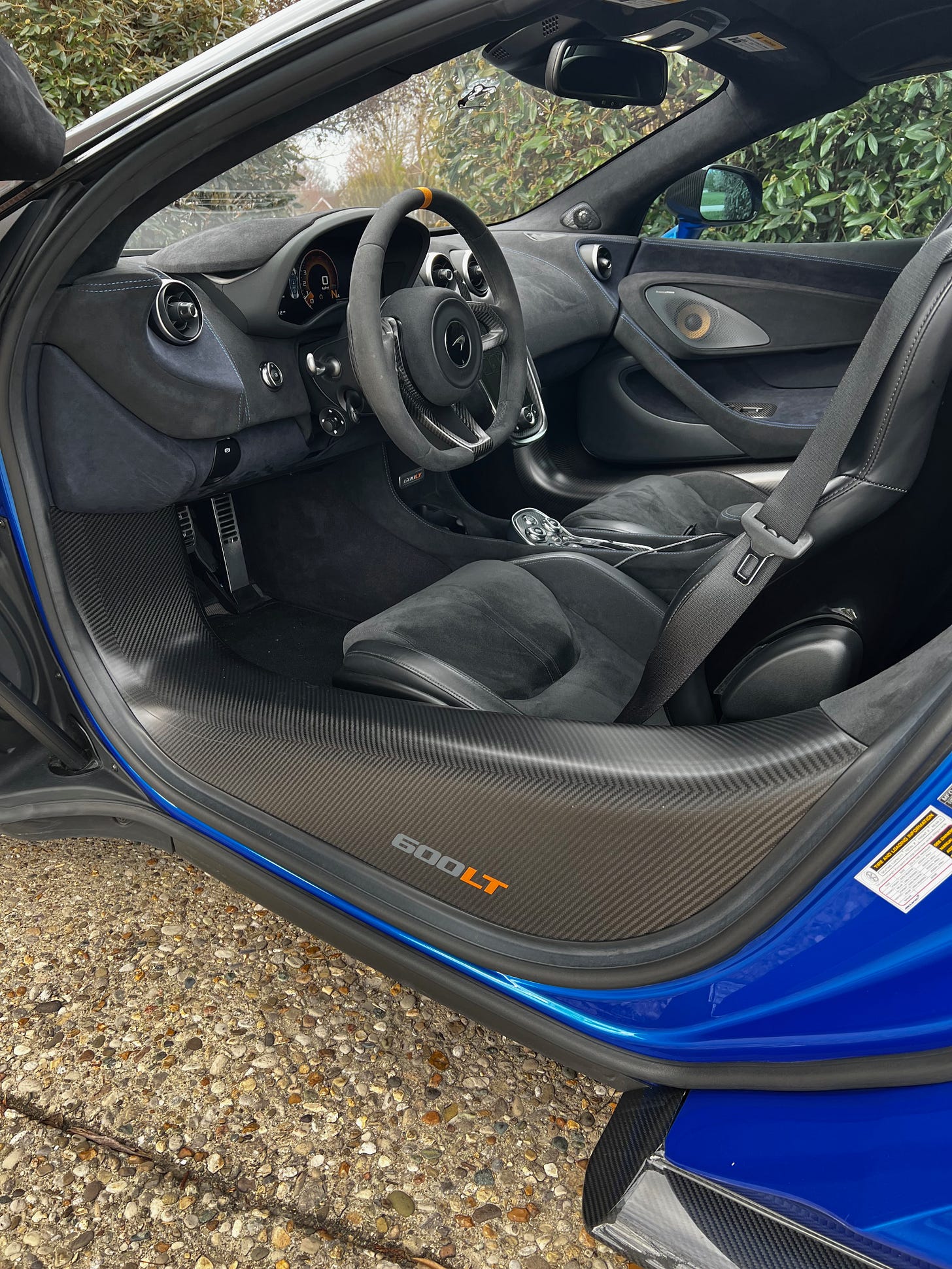As I look back, it’s hard to believe it’s been nearly a year and a half since I parted ways with my 2020 McLaren 600LT Spider. Time has flown, and here we are in August 2024, reflecting on an experience that was nothing short of exhilarating. Over the course of 10,000 miles, this McLaren became more than just a car; it was an adventure, a companion, and a constant source of joy.
A Question of Comparison: McLaren vs. Porsche GT3 RS
One question I’m often asked is how the McLaren 600LT Spider compares to my previous ride, the Porsche 991.2 GT3 RS. To put it simply, I loved the McLaren. Every drive was an event, a moment to savor. While the Porsche is an incredible machine in its own right, the McLaren took things to a different level. The dihedral doors alone made every entry and exit feel like stepping into a supercar fantasy. And in Vega Blue, the car was a stunner—a rolling work of art that demanded attention.
The McLaren sits five inches lower than the GT3 RS, and that low-slung driving position adds to the sense of occasion. The carbon fiber monocoque shell made the Spider as rigid as its coupe counterpart, eliminating the cowl shake that can plague other convertibles. This was a car that felt solid, connected, and ready for anything.
Inside the Cabin: Minimalist, Yet Focused
Stepping inside, the interior was swathed in Alcantara, with midnight blue stitching that added a subtle touch of elegance. The minimalist approach extended to the steering wheel—no buttons, just pure focus on the driving experience. The infotainment system was basic, lacking CarPlay, but it got the job done. The air conditioning controls, housed within the screen, were functional if a bit cumbersome to use while on the move.
Storage was minimal, as expected in a car like this. The door pockets offered some space, but there was no glovebox and a small center console. A net between the seats served as a spot for essentials like insurance and registration. Surprisingly, there were two cup holders—though I can’t say they saw much use, given the nature of the car.
The Drive: Unmatched Dynamics and Precision
When it comes to driving dynamics, the McLaren 600LT Spider is the best car I’ve ever driven. Yes, even better than the GT3 RS. The suspension setup, with double wishbones at all four corners and adaptive dampers, made for an incredibly smooth ride. The car’s longer wheelbase, seven inches longer than the Porsche’s, contributed to its compliant nature on the highway, while still being a beast in the mountains.
The front tires, at just 225mm wide, were a revelation. The grip was endless, allowing the car to be chucked into corners with confidence. The rear tires, at 295mm, provided adequate grip, and understeer was minimal—most of it dialed out with an alignment by Winning Formula, who know their stuff.
The steering was telepathic, a direct link between your thoughts and the road. Every input was met with immediate response, defying the laws of physics as the car darted through corners. The brakes were equally impressive, with carbon ceramic discs that inspired confidence and never faded, even under hard use. The pedal feel was unique—initially feeling rock-solid, but with practice, it revealed a range of modulation that allowed for precise control.
Under the hood, the 3.8-liter twin-turbo V8 was a powerhouse, delivering 600 horsepower with a visceral edge. Turbo lag was minimal, and the engine pulled hard out of corners, providing a rush of acceleration that was addictive. The 7-speed dual-clutch transmission was lightning fast in manual mode, though a bit laggy in automatic. The solution? Drive in manual mode all the time—problem solved.
The pops, cracks, and occasional flames from the exhaust added to the drama, especially with the top down. This was a car that made you giggle like a teenager, a car that turned every drive into an event.
Reliability: The Good, the Quirks, and the Reality
Now, let’s talk about reliability—a topic that often comes up when discussing McLaren. There’s a lot of noise out there, much of it from people who’ve never owned one. In my experience, mechanically, the 600LT Spider was solid. The engine, transmission, brakes, and suspension were all dependable. But like any low-volume, hand-built exotic, it had its quirks.
One of the most common issues was the “key not found” message, which required a simple (albeit annoying) fix: get out of the car, lock it, walk 20 feet away, then unlock and start again. It worked every time, but it was still a quirk. The door switches, particularly when wet, could also act up, causing the windows to misbehave. Fortunately, this was covered under warranty.
Starting the car required firm pressure on the brake pedal—anything less, and it wouldn’t start, leading to some frustration until you figured it out. Servicing the car was another story. If you’re not near a McLaren dealer, it can be a bit of an inconvenience. However, companies like McMedics, with ex-McLaren techs who travel to you, offer a solution, albeit not a cheap one. Routine servicing wasn’t inexpensive, but if you’ve owned a Porsche, it’s not too extreme.
The car came with Pirelli P Zero Corsa tires, specific to McLaren. They offered incredible grip and better wet traction than Michelin Cup 2 tires, though they wore quickly and could get noisy as they aged.
Final Thoughts: Would I Do It Again?
So, would I own another McLaren? Absolutely. The 600LT Spider was a thrilling, engaging, and unforgettable car. It may not have been perfect, but its imperfections were part of its charm. It was a car that made every drive special, a car that left a lasting impression. And while the 765LT Spider and the McLaren P1 are still dreams, for now, the 600LT Spider will remain a cherished memory—a car that defined a year of driving, fun, and endless smiles.






